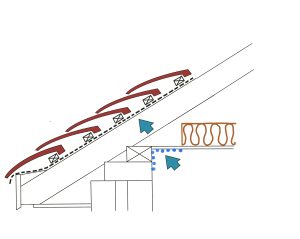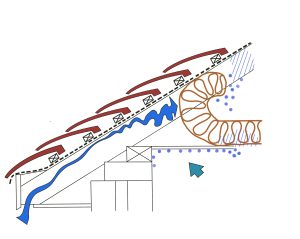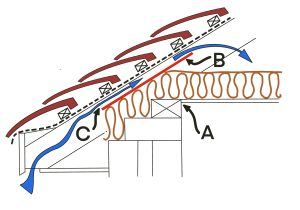Condensation Problems in Roof Voids from Insulation
Insulation and Ventilation in Roof Voids requires special attention, particularly at the eaves level, to avoid potential issues like condensation.
During our residential survey inspections, we often discover either missing insulation at the roof’s edges (specifically at the eaves level) or insulation that has been improperly installed, obstructing essential ventilation (see figures 1 and 2 below).
Inadequate Eaves Insulation and Cold Bridging (Figure 1):
- When insulation is not extended into the eaves, it leaves the edges of the ceiling below insufficiently insulated.
- This creates a phenomenon known as “cold bridging,” where a direct pathway for heat loss is established through the uninsulated eaves area.
- Cold bridging can result in localised temperature variations, making it prone to condensation and mould growth at the junction of the wall and ceiling.
Over-Insulation or Blockage (Figure 2):
- Pushing or blowing insulation too far into the eaves or leaving it partially unrolled can obstruct cross ventilation.
- Cross ventilation is vital for preventing condensation.
- Without proper cross ventilation, moisture from within the house can condense in the roof void. This leads to mould growth; high moisture content in the roof timbers; rot; and corrosion of steel fixings, nails, and connectors in the roof space.
- The resulting condensation can also saturate the insulation, reducing its effectiveness and causing damage to ceilings and decorations.
In today’s energy conscious world, roof voids require comprehensive insulation coverage. However, unobstructed ventilation is equally crucial. In practice, it’s essential to follow the guidelines below:
- Ensure complete coverage of insulation above the ceiling at the eaves level (Location A in Figure 3).
- Confirm that the insulation is placed up to (but not obstructing) stops or spacers to ensure roof ventilation (Location B in Figure 3).
- After installation, confirm that cross ventilation, as designed, remains unblocked (Location C in Figure 3).
By following these recommendations, you can ensure that your roof is properly insulated to help keep heating bills down whilst also maintaining essential ventilation to prevent condensation-related problems.
Further related reading:
-
- SPAB (Society for the Protection of Ancient Buildings):
- Website: https://www.spab.org.ukhttps://www.spab.org.uk/advice/loft-insulation/
- SPAB focuses on the preservation and conservation of historic and older buildings. They offer valuable resources related to insulation, ventilation, and preservation practices.
- SPAB (Society for the Protection of Ancient Buildings):






